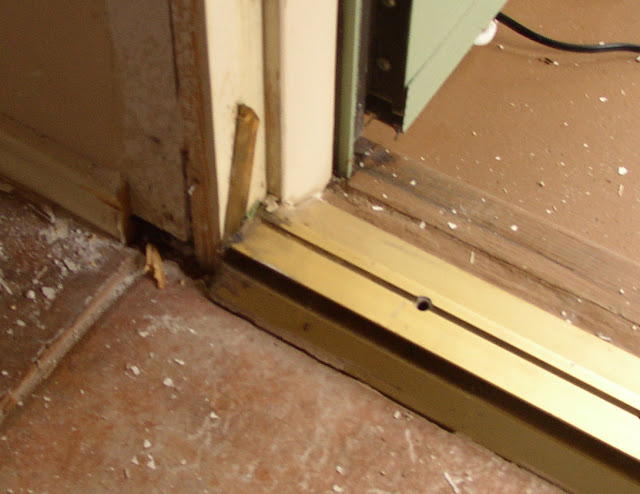What can I do today to help the door on my house work better?
Knowing about adjustability in door thresholds.
I've been a window and door installation contractor for almost thirty years. To this day I'd say only half the installers even give this fact any thought or share it with new customers. Folks who have never purchased a door in their lives would have no reason to know this interesting fact.
Many, and in fact most modern door thresholds from the 80's forward are adjustable and can be made tighter or looser depending on the need on the home. They raise and lower with an adjustment screw and most doors have at least 5 along the top. Moving those thresholds up will make a better, tighter seal.
Here's an example picture...
The gold screw in the center of the oak strip is an adjustment screw. It will move the oak strip up when loosened and will move it down when tightened. It' is usually a #3 Phillips as seen here but the plastic threshold top with caps over it has flat head adjusters. It was typical on cheaper door models.
I've never seen a plastic adjustable threshold and had the customer know it was adjustable. This is often also the case with the Oak ones like you see here.... Very few folks know you can make it tighter or looser as needed.
In the winter it is certainly preferable to make the door tighter and get a better seal. Also tighter seals will prevent some door slamming often associated with children and other wild animals that move through doors too quickly. When the threshold is tight the door won't really slam. They have to slow down and push it shut. I like that when I'm napping. I hate slamming doors.
This is by far one of the best 5 minute fixes on the house before it gets cold.
If you see someone with a towel by the door or some kind of door cozy U shaped stuffed animal hugging a friend or neighbor's door, you may want to share this awesome tip as well.
Older style thresholds and their adjustment.
The old metal style are tougher but when needed can be shimmed up on one side or another with shims from the local lumber store. Then reseal the door to the floor with a clear sealant after making sure the door is sealing well. Doors usually settle on one side or another and while this fixes the bottom, it really doesn't help the sagging or twisting that happens as a home settles over time.
These tips help with the seal at the bottom of the door, but can't fix bigger issues with the door and how it aligns with the jambs and weatherstripping on the jambs.
A sad reality is that houses settle, the wood succombs to the weight of the roof and upper components and moves down. Sometimes as little as a quarter inch of movement can really throw out a doors fit.
The real fix for that issue is more like removing interior and exterior trim, cutting all the nails and actually moving the frame to a better location.
If this goes terribly south, you can always go to the lumber store and buy a replacement door. Not a great one like I usually install, but one to do the job. For reference sake, you may want to read my blog post from last year on door installation best practices.
Actual exterior door installation instructions can be found from this earlier post:
How to install an Exterior Pre- Hung Door
http://thewindowconnection.blogspot.com/2015/02/how-to-install-exterior-pre-hung-door.html

